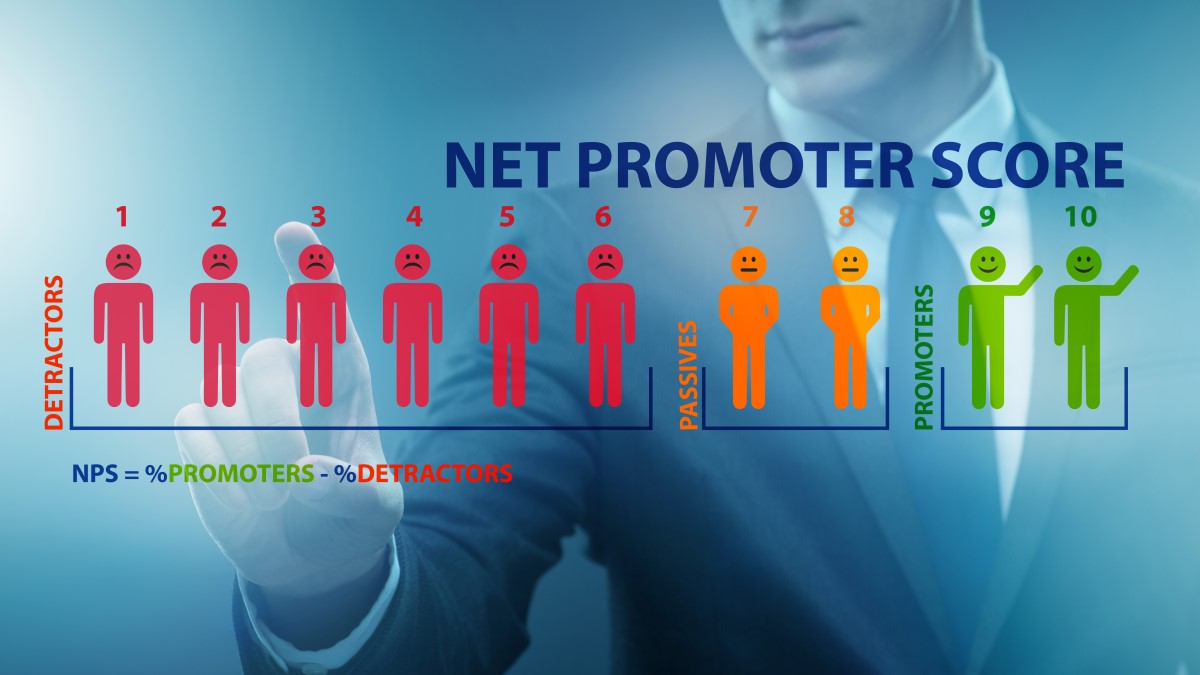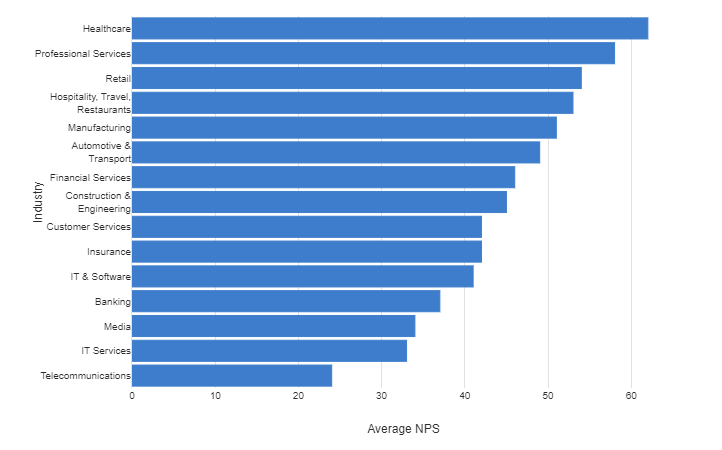NPS Surveys: How do I know when I’ve got a good score?

Having been in existence for around twenty years, it’s likely that many of you will be familiar with the Net Promoter Score® survey and the key NPS® question - “How likely is it that you would recommend our [company] [product] [service] to a friend or colleague?
However, even if you know how to calculate NPS, knowing if you’ve achieved a good score can be a more challenging process altogether.
While a good Net Promoter Score is technically anything above zero, as this implies that you have more promoters than detractors, it’s not quite as simple as that. This is because there are two main methodologies that help ascertain what a good NPS score is. The first examines the strength of your NPS, regardless of the industry you work in, while the second method measures your NPS score with respect to your wider industry.
So, to help get some answers, it’s useful to go back to the beginning...
What is a good NPS score?
Well, if we consider this in its purest form according to the NPS metric’s original creators Bain & Company, then any score above 20 is great, beyond 50 amazing and above 80 considered to be in the top percentile.
Yet, as we’ve already mentioned it’s not quite as straightforward as that and depends on whether you’re using the absolute or relative NPS method. While in the absolute sense, any NPS score over 50 is considered above average, if you’re looking to benchmark your score with competitors using the relative method, then an above-average NPS score can be anywhere from 0 – 40+ depending on your industry.
At this point it can be helpful to revisit and summarise the two main methodologies that determine what constitutes a healthy NPS score, which are as follows:
The absolute NPS method:
Relies on comparing your score to a loosely agreed-upon standard for what a good score is, across all industries.
The relative NPS method:
In contrast this approach focuses on comparing your score to other companies within your industry.
So, having summarised these two main approaches to NPS, it’s time to look more closely at each method.
The absolute NPS method
If you’re using the absolute NPS method to determine whether you have a good NPS score, it can be helpful to have a breakdown of the different score categories, so you can see how well you’re doing under this approach.
- Score of –100 to zero: if you’ve attained a score that’s zero or below then that’s a bad sign. It essentially means that the majority of your customers are having a bad experience and are unhappy with your company. Even worse, there’s a good chance that they’re also telling others to avoid purchasing any goods or services from you.
- Score of zero to 30: this is an acceptable range to reside in as it highlights that you have slightly more promoters than passives and detractors. While many of your customers have room for improvement in their experiences, you're at least doing a few things right.
- Score of between 31 and 50: this is where the greatest number of companies tend to reside. If you’ve scored in this range then your product generally delivers on its value and the majority of your customers are satisfied, with a solid number of these happy to recommend you to other people that they know.
- Score of between 50 and 70: if your score resides here, then you’re doing really well. This is where many of the world’s beloved brands sit. Customer perception is hugely positive and brands in this category have a larger than average group of promoters sharing their positive perception with their personal networks.
- Score of between 71 and 100: if your score resides here then you’ve reached a level that’s rarely attainable. A company with a score in this range is considered to be among the finest in their industry.
This method offers a good start for your journey using NPS, but it’s not conclusive, as everyone runs their NPS program slightly differently and every industry has different dynamics. It’s a bit like trying to compare apples with pears. For a more precise comparison you might like to try the relative NPS approach.
The relative NPS method
As we stated a bit earlier, the second approach to exploring whether your NPS score is a good one or not, is to compare yourself relative to others in your industry.
By checking the relative NPS for your industry against your own NPS score, you will quickly be able to ascertain if you’re doing better and growing faster than your competitors. This is because by nature businesses with higher NPS scores get more recommendations and more customers as a result, as these customers are more likely to buy from companies they’re recommended to, rather than those that they’re not.
Not only that, but companies with a healthier NPS, are more likely to publicly advertise these scores with their shareholders and customers, as evidence of their company’s success relative to others in their industry. And this alone encourages more customers to do business with them too.
However, it’s important to point out that average scores can vary widely across industries, as the following graph highlights:

To properly evaluate this graph and assess why some industries appear to have a lower average NPS score than others, you also need to think about the context of that particular industry. This is because some industries can still thrive, even if they provide less than satisfactory customer experiences, due to the way businesses in that sector are set up.
For example, consider companies that provide critical services, or have very little competition such as those in some utility markets or cabling industries. If they’re providing a necessity service that customers can’t do without, or the customer has few alternatives they can swap to, those companies providing the service are likely to retain customers and acquire new ones, even if their customer service and subsequent NPS score is poor.
In contrast, the success of businesses in other industries can be totally reliant on NPS, whereby they would struggle to exist without delivering a high-quality differentiated experience. These companies operate either in highly competitive markets and need to compete on a differentiated experience, or their core product is at the luxury end of the market where demand is highly elastic.
Whatever challenges those reliant on having a good NPS score face, those struggling with a poor NPS, need to find ways of improving their NPS score and quickly if they are going to survive.
How to improve Net Promoter Score
Fortunately, there’s a number to things you can do to help improve your NPS score moving forward.
Here are a few considerations to think about:
Staff education
How many people within your organisation are aware of the Net Promoter Score and its implications for your business?
If awareness levels are low, you need to focus on developing a customer strategy and share it with all your client-facing teams to inspire them to follow these guidelines in all their business communication.
The objective here is to get them to understand that each and every customer matters and encourage them to proactively seek feedback and promptly transmit it to the department responsible for customer happiness and success.
Try to keep all your customer communications positive
Every interaction you have with a customer can result in a positive or negative experience of your brand.
So, when it comes to your customer communications, make sure every call begins on the right not. Keep your greeting friendly, start with some brief small talk, before moving on to business, asking questions to understand their problem and trying to suggest a solution.
Show them how valuable they are to you as a client for your business. Try to make sure every conversation ends on a positive note, because that’s the impression the customers will be left with.
Encourage customer feedback
Try to open yourself up to customer feedback, so you can gather, study and learn from it.
Encourage your clients to submit product or feature requests, get them involved in conversations about your roadmap for the future, and let them schedule onboarding and support calls.
Demonstrate that you hear them and are ready to lead a productive collaboration with them.
Always try to follow up with customers
Whenever you receive customer feedback, follow up with that customer to thank them for their ideas and openness.
Let them know how their feedback will be processed and used. And whenever you have anything positive to share with a client, such as a new product feature release, email them personally to notify them about the achievement and tell them they were a part of it.
Convert NPS detractors into NPS promoters
You can make a big difference to improving your NPS score, by developing a separate communication strategy that is focused on your detractors.
Follow up on them, invite them to collaborate with you and listen to their problems. Be honest in your communications with them and acknowledge any imperfections your business has. Try to fix their core issues and switch their customer experience into one that’s more positive in tone, helping to turn them into promoters.
Don’t leave out passives either
Don’t forget your passives. While they don’t currently affect your score, it’s worth figuring out what could persuade them to become an ambassador for your company.
While it can take time and patience to earn their loyalty due to their fickle nature, by involving them in conversations and showing that you can offer more than just a product or service, their general perception might change to your advantage.
Only continual improvement keeps customers returning
Having read about the main methods for identifying a good NPS score and the typical NPS scores achieved in many of today’s industries, we hope you will feel better informed about what makes a good NPS score.
Although, it’s useful to be able to compare yourself with others, the key thing to remember is to try and make your NPS score as good as you can make it. This is because a higher NPS score not only translates into more recommendations and more customers choosing you, but it also improves the loyalty and retention of your existing customer base. And given that it costs up to five times more to acquire a customer than retain one, that’s a significant cost saving.
However, you’ll only achieve that if you can continually improve, which relies on you surveying your customers for feedback and analysing and acting on that feedback. If you can do that, then your customers are more likely to return and keep buying from you, which is the key to your future growth and success.
NPS®, Net Promoter® & Net Promoter Score® are registered trademarks of Satmetrix Systems, Inc., Bain & Company and Fred Reichheld.
